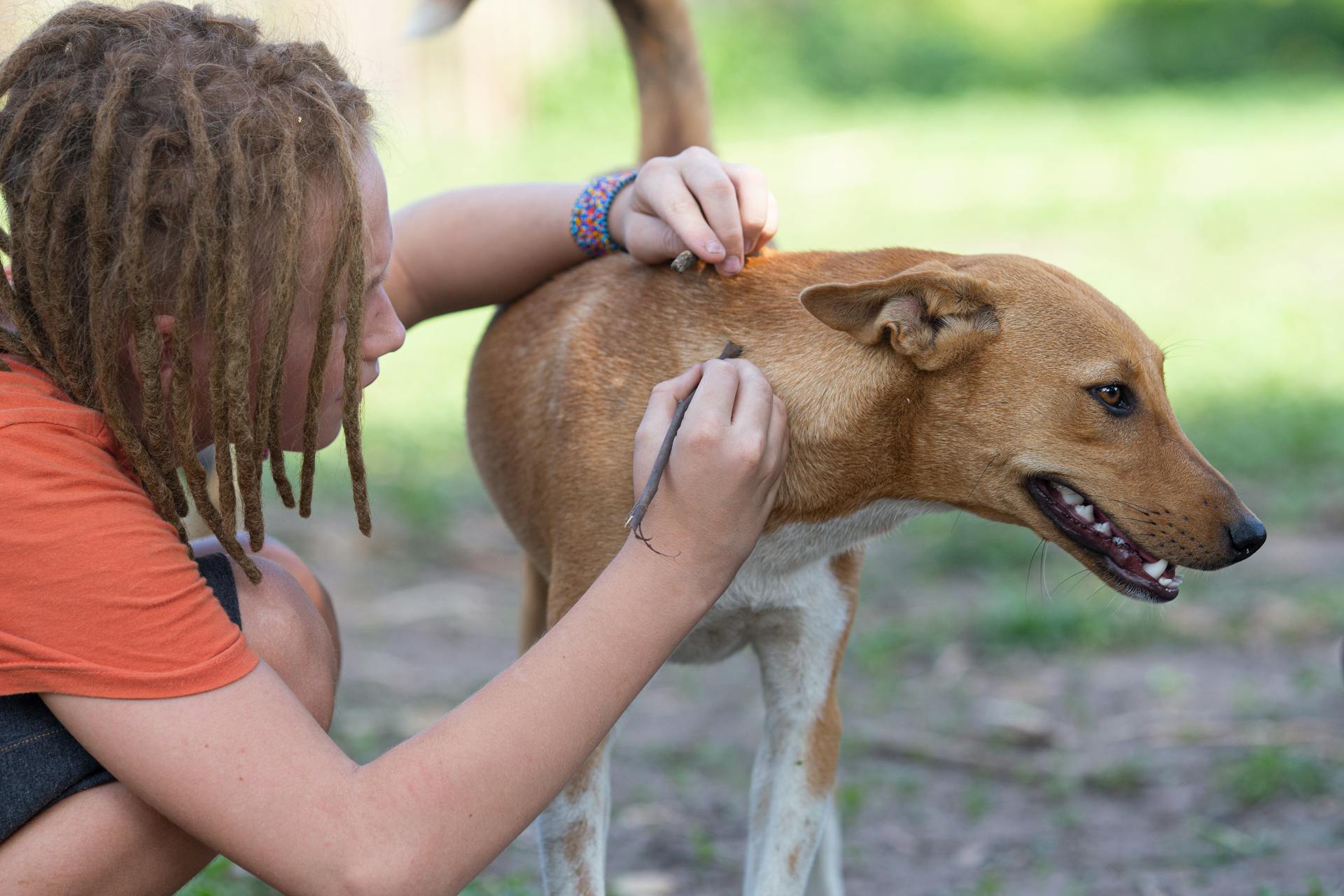
Flea treatment for dogs is a regular necessity, especially during peak flea seasons.
The frequency of flea treatment depends on factors like your dog's lifestyle and location.
Dogs that spend more time outdoors, especially in areas with high flea activity, may require more frequent treatment.
Typically, flea treatment should be done every 2-4 weeks to maintain effectiveness.
Flea Treatment Options
Flea treatment options are numerous, and the right one for you will depend on your dog's age, weight, and personal preferences.
Topical spot-on treatments are a popular choice, as they can prevent flea infestations for up to a month at a time. Advantage is a spot-on solution that kills fleas within one day and continues working for four weeks.
Flea shampoos can be an effective short-term solution, but they won't keep larvae and eggs from continuing to hatch and feed on your dog. Medications in flea shampoos only tend to work for one day or less.
Flea collars are another option, but their effectiveness is a hot debate. Some collars emit a gas that repels fleas, while others are coated in chemicals that kill fleas when your dog is bitten.
Oral treatments are estimated to be 99.9% effective at killing and preventing fleas. They come in the form of chews and tablets that dogs can take once a month.
Flea powders and sprays can offer short-term protection, but they may need to be reapplied repeatedly over a certain period of time. Look for products that discourage the development of flea eggs and larvae, in addition to killing adult fleas.
NexGard is a popular oral treatment that kills fleas within 6-8 hours of product administration. It's suitable for puppies from 8 weeks of age and 2 kg bodyweight.
Broaden your view: Do Dog Flea Collars Work
Prevention and Preparation
Prevention is key when it comes to keeping your dog flea-free. It's far easier and usually cheaper to prevent fleas than to treat them after an infestation has occurred.
For some pet owners, using a flea and tick prevention collar is a great option. These products, such as Seresto, can be effective for up to eight months and are labeled for over-the-counter use in dogs. They work within hours and are a convenient way to keep your dog protected.
Regular treatment is essential, especially if you're planning a trip to a kennel. All good kennels will require you to treat your dog for fleas before they board, so make sure to check the product information and inform the kennel when it needs to be re-applied.
Prevention
Prevention is key when it comes to keeping your dog flea-free. It's far easier and usually cheaper to prevent fleas than to treat them after an infestation has occurred.
Using a flea and tick preventive medication collar is a great way to start. These products come in different forms, but Seresto is a newer product that has greater efficacy than older products. It's labeled for over-the-counter use in dogs and can be effective for up to eight months.

If you're considering using a topical spot-on treatment, look for products with the fewest ingredients. Avoid spot-ons with extra ingredients that cover a range of pests, as they can be toxic to your dog.
Some popular active ingredients in spot-on treatments include fipronil, imidacloprid, and permethrin. These chemicals disrupt the insect's central nervous system and cause hyperexcitation of its nerves and muscles.
To keep your dog flea-free, you'll need to treat them regularly. The frequency of treatment will depend on the product you're using. Some products, like Seresto, can last for up to eight months, while others may need to be reapplied every month.
If you're planning to leave your dog at a kennel, make sure to treat them for fleas before you go. This will ensure that your dog is protected from fleas while they're away from home.
Here are some flea prevention tips to keep in mind:
- Use a flea and tick preventive medication collar or topical spot-on treatment.
- Choose a product with the fewest ingredients.
- Avoid spot-ons with extra ingredients that cover a range of pests.
- Treat your dog regularly, depending on the product you're using.
- Inform your kennel of your dog's flea treatment schedule.
- Consider using a high-quality flea shampoo to bathe your dog.
Remember, prevention is key when it comes to keeping your dog flea-free. By following these tips and using the right products, you can keep your dog happy and healthy all year round.
Collars and Bandanas
You can create your own flea and tick collar by using diluted essential oils as instructed above.
Add a few drops to a fabric collar or bandana that your dog will wear, but use them for outings only, so your dog isn't breathing in the oils 24/7.
These homemade collars can be a convenient and natural alternative to store-bought options, but remember to take them off when your dog comes indoors.
This way, you can still protect your dog from fleas and ticks without exposing them to harsh chemicals for extended periods.
For another approach, see: Essential Oils for Dog Flea Repellent
Treatment and Medication
Treatment and Medication is a crucial aspect of flea control. Topical spot-on treatments, such as Advantage, can prevent flea infestations for up to a month and kill fleas within one day.
Flea tablets, like Capstar, can start killing fleas in as little as 30 minutes and can be used as an attack treatment to disrupt the flea lifecycle. Oral treatments, including NexGard for Dogs and NexGard SPECTRA for Dogs, are estimated to be 99.9% effective at killing and preventing fleas.
Oral preventives, such as Isoxazoline medications, offer great efficacy against fleas and several types of ticks. They can be effective for up to eight months, such as with the Seresto Flea and Tick Control Collar.
Here's a quick rundown of common flea treatments:
- Topical spot-on treatments (e.g. Advantage): up to a month of protection
- Flea tablets (e.g. Capstar): fast-acting, but only lasts for a day
- Oral treatments (e.g. NexGard for Dogs, NexGard SPECTRA for Dogs): 99.9% effective at killing and preventing fleas
- Oral preventives (e.g. Isoxazoline medications): up to eight months of protection
Sprays
Flea sprays can be used directly on your dog, but only if they're designed for animals. Never use a household flea spray on your pet.
Pet flea sprays can kill fleas, but may need to be re-applied from as often as every few days, up to every few weeks.
Frontline Spray is a flea and tick spray that can be used on puppies from 2 days of age, offering protection against fleas and ticks.
For your interest: Dog Flea Spray Diy
Treatment
Treatment is a crucial part of managing flea infestations.
Topical flea treatments, such as shampoos and sprays, can be effective but only kill adult fleas, not larvae or eggs.
Flea collars are another option, but their effectiveness is debated, and it's essential to discuss them with your veterinarian.

Spot treatments are available over the counter but should be used under the guidance of a veterinarian.
Flea powders and sprays can provide short-term protection, but many only kill adult fleas, not larvae or eggs.
Oral treatments, such as chews and tablets, are estimated to be 99.9% effective at killing and preventing fleas.
Isoxazoline medications, like Credelio, are a newer and highly effective preventive that offer great efficacy against fleas and several types of ticks.
Here are some active ingredients to watch for in oral flea and tick medications:
- Afoxalaner – a member of the isoxazoline family
- Fluralaner – for systemic use and also a member of the isoxazoline family
- Sarolaner – an acaricide and insecticide also belonging to the isoxazoline family
- Lotilaner – an ectoparasiticide belonging to the isoxazoline family
- Spinosad – made from soil bacteria that is toxic to insects and found in garden insect spray
- Lufenuron – controls flea infestations by preventing the hatching of eggs, and prevents the flea shell from developing
If you see ingredients from the first list AND the second list, you're getting unnecessary and harsh dewormers.
Signs that flea and tick medication is working on your dog include dead fleas within 24 hours, and a decrease in itching within a few days.
Collars
Flea and tick collars are a popular choice for pet owners, but not all collars are created equal. Some older products use insect growth regulator ingredients that vary in efficacy.
Readers also liked: Are Dog Flea Collars Safe
Seresto is a newer product that stands out from the rest, offering greater efficacy and labeled for over-the-counter use in dogs. It works within hours and can be effective for up to eight months.
You can find flea collars on the market that vary in terms of coverage, but Seresto Flea and Tick Control Collar offers the longest protection from fleas and ticks available for dogs and cats. It's water-resistant and doesn't leave any greasy residue on your pet.
The chemicals in these collars release into the area around your dog and into his skin, then circulate through the bloodstream. When a flea or tick draws blood from your dog, it's infected with the chemical and dies.
Flea collars are for external use only, but your dog will easily ingest the collar's pesticides through licking and grooming. This can be a concern, especially if your dog has open wounds or constant exposure to the chemicals.
You can create your own flea and tick collar by using diluted essential oils and adding them to a fabric collar or bandana. Just be sure to take it off when your dog comes indoors, so they're not breathing in the oils 24/7.
Curious to learn more? Check out: Can a Dog Wear a Cat Flea Collar
Signs and Effectiveness
Dead fleas can start appearing within 24 hours of administering flea and tick medication to your dog. This is a clear sign that the treatment is working.
It's essential to note that it may take a few days for the itching to decrease, even after the fleas are killed. Regular monthly treatment is usually recommended to keep pests away for good.
Ticks are harder to kill than fleas, and it may take up to 48 hours for a treatment to work, depending on the type of treatment.
Get Rid of Clutter
Getting rid of clutter is an essential part of maintaining a flea-free home. Clutter can harbor flea eggs and larvae, making it harder to get rid of them.
You should vacuum daily, even if you have hardwood or tile flooring, to remove flea eggs and larvae. Discard the vacuum bag or empty the canister immediately after use to prevent the eggs from hatching.
Curious to learn more? Check out: Can You See Flea Eggs on a Dog
Wash all bedding with hot water weekly to keep fleas at bay. This includes your dog's bedding, as well as any other bedding in the home.
Keep a neat yard to prevent fleas and ticks from taking over. Fleas and especially ticks love shaded, dense areas, so keep a distance between your home and any forested areas, dense brush, or tall grasses.
Here's a quick checklist to help you get started:
- Vacuum daily
- Wash bedding weekly
- Keep a neat yard
Frequently Asked Questions
How soon can I give my dog another flea treatment after?
Wait at least four weeks after the first treatment before giving your dog another flea treatment to avoid an overdose. Consult the product instructions for specific guidance on re-treatment timing
Can you over flea treat a dog?
Yes, it's possible to over flea treat a dog, which can lead to serious health issues. Misusing flea medication can cause adverse reactions, so it's essential to follow the recommended dosage and consult with a veterinarian for guidance.
Sources
- https://mypetandi.elanco.com/en_gb/parasites/fleas/how-often-should-i-flea-my-dog
- https://www.greensboroncvet.com/site/friendly-animal-clinic-blog/2020/09/15/flea-treatment-for-dog
- https://www.petmd.com/dog/general-health/how-long-do-flea-and-tick-medications-take-work-dogs
- https://www.dogsnaturallymagazine.com/new-fda-warning-about-flea-and-tick-medications/
- https://nexgard.com.au/dog-parasites/fleas/flea-treatment-for-dogs
Featured Images: pexels.com


